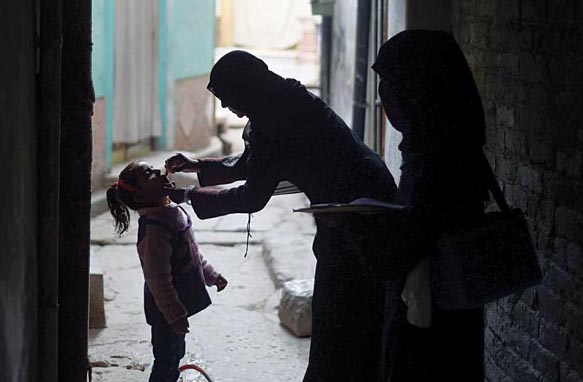
There was a drastic reduction in the number of reported polio cases in 2015. The polio cases dropped from the 306 recorded in 2014 to 51 in 2015. This is the lowest-ever count recorded since 2009, according to official data.
Polio cases drop by 70% in 2015: govt
Polio remains endemic in just two countries – Pakistan and Afghanistan. Until poliovirus transmission is interrupted here, all countries remain at risk of importing the wild poliovirus.
Last year in Pakistan, the highest number of polio cases was reported from the Federally Administered Tribal Areas (Fata). The tribal areas accounted for 16 cases last year as compared to the 179 reported in 2014.
The second highest number emerged in Khyber-Pakhtunkhwa, where 15 polio cases were reported in 2015, as compared to 68 reported in the previous year.
Sindh reported 12 cases in 2015 while the count was 30 in 2014. The restive Balochistan province reported seven cases last year, whereas the count was 25 the previous year. Only one case was reported in Punjab, where five emerged in 2014.
Crippling disease : Karachi’s first polio case of year confirmed
The official result of the last anti-polio campaign held in December 2015 reveals the overall coverage of the vaccinations remained above 90% across the country, except in Quetta and Qilla Abdullah in Balochistan.
Dr Rana Muhammad Safdar, the emergency coordinator of Polio Eradication Pakistan, said the last nationwide anti-polio campaign was termed the “best-ever drive”, where even the independently assessed coverage was over 90% in all provinces.
Talking to The Express Tribune, he added there had been a massive decline in the number of children missing polio vaccinations in 2015 as compared to 2014.
In 2014, around one million children had missed polio drops. The number was reduced to 500,000 in the first half of 2015 and later to below 100,000 in the last anti-polio drive.
Similarly, the number of districts from where new infections were reported and environmental samples tested positive for wild poliovirus decreased by half – from 44 in 2014 to 22 in 2015.
Military offensives against militants gains ground in battling polio
Dr Safdar said improvements were also seen in the security cover provided to the polio health workers in 2015. “Only one attack on polio workers was reported in 2015, whereas there were around 20 to 30 in 2013-14,” he said. “It has really helped boost the morale of the polio workers.”
Punjab emerged as the best performer. One of the landmark achievements was vaccinating children in bulk in Fata, which was earlier inaccessible for polio teams due to security reasons.
Karachi, however, remained a problematic area for polio eradication throughout the year. The metropolitan city reported seven cases in 2015 and continues to be a major hurdle.
“We have decided to shift from carrying out phase-wise anti-polio campaigns in Karachi to a one-phase drive in order to have better results,” Dr Safdar said.
Published in The Express Tribune, January 5th, 2016.























COMMENTS (12)
Comments are moderated and generally will be posted if they are on-topic and not abusive.
For more information, please see our Comments FAQ